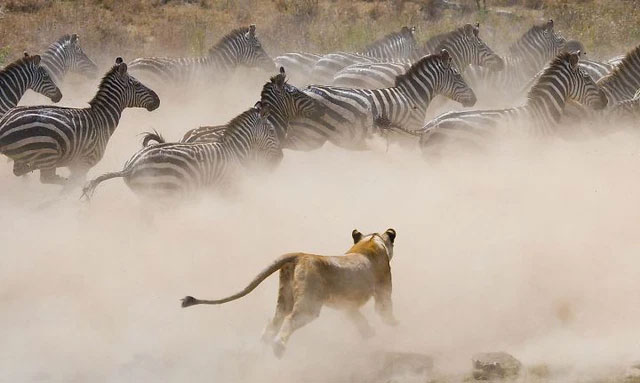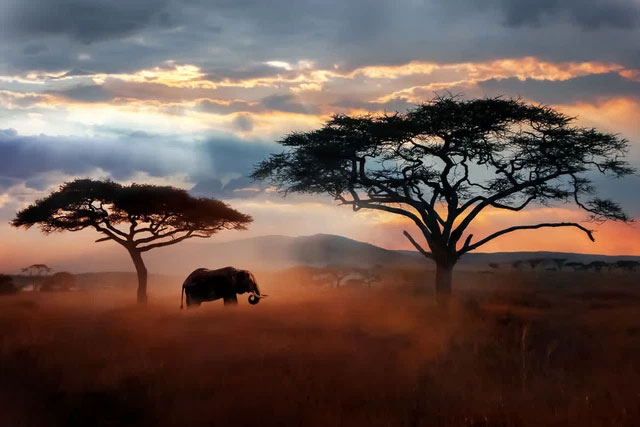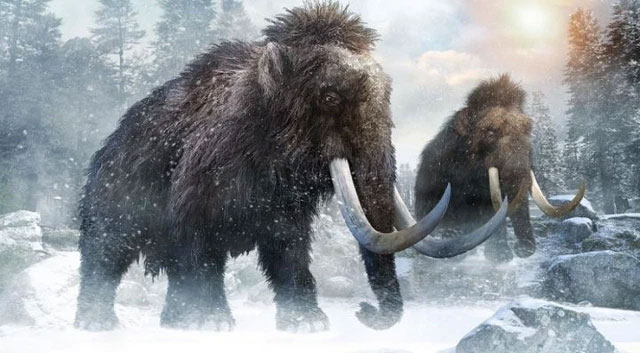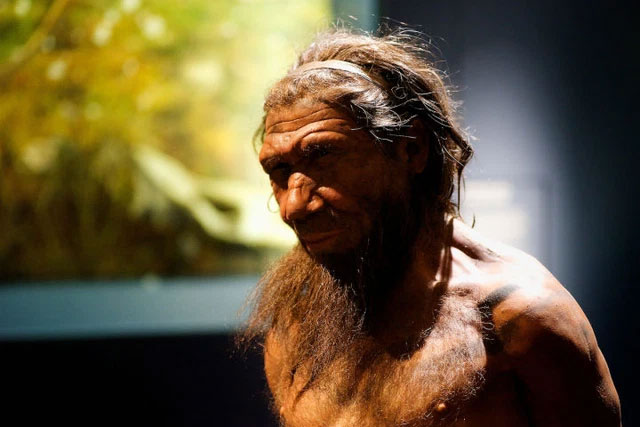Humanity – Homo sapiens, despite having only appeared for a relatively short time in comparison to the history of Earth, has made significant impacts on our blue planet, affecting the environment, climate, and ecosystems. Have you ever wondered what Earth would be like if we had never existed?
From the towering skyscrapers of modern cities to the pyramids and other ancient architectural wonders left by history, we can see traces of human existence both in the past and present across the globe today. The vast rice fields and the roads extending in all directions also bear the marks of human activity. But what would the world look like if humans had never existed?
Trevor Worthy, a paleontologist and associate professor at Flinders University in Australia, states: “I think Earth would be a place with more lush vegetation, with a large number of animal species, and large animals would roam across the continents, except for Antarctica.”
A world without modern humans would also mean that our relatives (Homo sapiens), such as Neanderthals, would still exist. And they would certainly change the landscape of the entire planet.

Without humans, many species would not go extinct.
The Earth Would Be Wilder
Humans have shaped the world, but we have also caused many species to face tragic ends, from the Dodo (Raphus cucullatus) to the Tasmanian Tiger (Thylacinus cynocephalus). Through overhunting and habitat destruction, we have driven these beautiful lives to extinction.
According to the most conservative estimates, the extinction rate of species on Earth today is over 100 times higher than it was in a world without humans. The natural decline led by humans suggests that without us, Earth would be a wilder place, and some giant animal species would not have vanished, such as the Moa.
Worthy mentions that this flightless bird, akin to an ostrich, could reach heights of 3.6 meters. It thrived in New Zealand for millions of years, but within just 200 years of human invasion of their land, all nine species of Moa, along with at least 25 other vertebrate species, disappeared from the planet forever, including the Hast Eagle (Hieraaetus moorei) that specialized in hunting Moa.
The Giant Eagle and the Huster Eagle are also recent examples of the disappearance of large animal species. Their extinction is linked to human activities, such as unsustainable hunting and the introduction of invasive species into their habitats.
The existence of large animals is crucial for speculating about what Earth would be like without humans, as these creatures have an extremely important impact on the landscape of our planet.

Humans play the most significant role in the extinction of many animal species.
The Earth Would Resemble the Serengeti
Sören Faurby, a senior lecturer in zoology at the University of Gothenburg, Sweden, believes that humans have played a crucial role in the disappearance of many large mammal species thousands of years ago. He led a study published in the journal Diversity and Distributions in 2015, which indicated that without humans, Earth would largely resemble the Serengeti today, a vibrant ecosystem in Africa.
If that were the case, the large animals found in the Serengeti today – including elephants, rhinos, and lions – would also inhabit Europe. For instance, not only would there be African lions as we see today, but Earth would also have cave lions, a slightly larger species that lived in Europe until about 12,000 years ago. According to Faurby, the Americas would also be home to giant relatives of elephants, bears, and even relatives of armadillos, such as Glyptodon, which were as large as a car and incredibly unique mammals.
Sören Faurby asserts: “In a world without humans, large mammal species would be more diverse, and if you see greater diversity among large mammals, you also see a more spacious habitat.”

Mammoths Would Still Exist
Large animals like elephants are referred to as megafauna. During the last ice age of the Pleistocene epoch (2.6 million to 11,700 years ago), the world was rich in wildlife. For example, according to a 2020 study published in the Proceedings of the National Academy of Sciences, at the end of the last ice age, approximately 38 large animal species in North America went extinct. Over the past century, scientists have debated whether natural climate change or overhunting by humans was the primary cause of the decline of these large animal species.
A study published in the journal Nature in 2021 concluded that climate change ultimately wiped out the true woolly mammoths (Mammuthus primigenius) that survived until the end of the Pleistocene, along with other large Arctic animals. Warming made the environment wetter, and the vegetation they fed on could no longer survive.
However, humans did hunt woolly mammoths. Not only does Faurby believe that humans could be the main factor leading to their extinction, but other scientists also think that woolly mammoths survived climate change before humans appeared. If humans had not exerted additional pressure on them, they very well could have survived to this day.

Without humans, woolly mammoths would still be alive.
Christopher Doughty, an associate professor and ecologist at Northern Arizona University, has modeled how large animals forage and defecate to disperse seeds and nutrients. His work shows that due to the extinction of large animals, the transport of elements such as phosphorus, calcium, and magnesium—essential for life—has been reduced by over 90%.
Doughty estimates that without humans, natural factors would be distributed more evenly across the landscape, meaning more fertile land and higher ecosystem productivity. Doughty states: “If the elements in the ecosystem are more fragmented, then productivity will be more fragmented.”
Doughty explains that humans cluster elements together through agriculture and establish barriers. Compared to wild systems, these areas would become less fertile over time.
The climate could also be different. While it is very difficult to know how humans and megafauna influenced climate change thousands of years ago, as evidence has been obscured over time, assessing our impact on today’s Earth climate is much easier. Due to global warming caused by activities such as burning fossil fuels, since the early 20th century, humans have increased the average temperature of Earth by about 1 degree Celsius. Therefore, without us, Earth would at least be cooler.
A 2016 study published in the journal Nature concluded that human-induced warming would delay the next ice age by at least 100,000 years. However, even without humans, the ice age would not arrive for another 50,000 years, so if we were to disappear, it is unlikely that Earth would enter another ice age.
Could Neanderthals Replace Us?
Modern humans (Homo sapiens) today have not always been the only species in this landscape, and even if we were removed from the evolutionary equation, Earth would still have the presence of humans, but that would be our relatives – the Neanderthals. Scientists are uncertain why Neanderthals went extinct about 40,000 years ago. There may be multiple reasons leading to the demise of Neanderthals, but we – Homo sapiens are often seen as the prime suspects.
Chris Stringer, a professor of human origins and head of research at the Natural History Museum in London, believes that competition for resources was a factor leading to the disappearance of Neanderthals. “If we had not appeared, if we had not entered Europe 45,000 or 50,000 years ago, I think they might still be around,” he says.
According to Stringer, Neanderthals had a complex life in Europe, similar to modern humans, but they struggled to cope with climate change, had relatively small populations, and low genetic diversity. However, not only Neanderthals could have replaced us.

Neanderthals and Denisovans are significant because if one or both of these lineages survived without humans.
Scientists are currently researching at least one lineage of humans: the Denisovans, who coexisted with modern humans and Neanderthals. The Denisovans appear to be genetically and physically closer to Neanderthals than to modern humans, but they differ from Neanderthals in having very large molars.
Humans may have interbred with Denisovans, as there is evidence showing that modern humans living in Oceania, New Guinea, and other areas possess Denisovan DNA. This discovery suggests that Denisovans interacted with the ancestors of modern humans, who later migrated further east into Southeast Asia, according to a study published in the journal Science in 2012. Previous reports from Live Science indicate that Denisovans also encountered Neanderthals in Siberia, where fossil remains of Denisovan-Neanderthal hybrids have been found.
The interactions of these Denisovans and fossil evidence suggest that they had a larger geographical range than Neanderthals and covered a more diverse environment. Therefore, it can be said that they possessed a much broader adaptive range than Neanderthals. According to Stringer, DNA evidence also indicates that Denisovans may have had greater genetic diversity than Neanderthals. “They may have been more likely to survive than Neanderthals.”
Both Neanderthals and Denisovans are significant because if either or both of these lineages had survived, they might have followed a similar path to Homo sapiens. By the end of the last Ice Age, they would have transitioned from hunting and gathering to developing agriculture.
Stringer stated: “Given enough time, there is no reason why Neanderthals or Denisovans couldn’t have done this, so the world might not be very different from today.”
“Similarly, they could also have made all the mistakes that we have made,” Stringer noted, suggesting that Earth would still experience warming. However, it is also possible that the Earth would look entirely different due to the development and evolutionary trends of Neanderthals or Denisovans, which remain permanent mysteries, and no one knows what would have happened.


















































